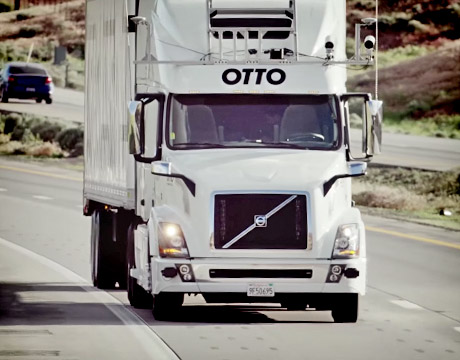From Tractor-Trailers to Self-Driving Machines
From Tractor-Trailers to Self-Driving Machines


A Volvo truck equippied with Otto’s self-driving technology. Image: Otto
When Anthony Levandowski left Google’s self-driving car project earlier this year to launch a company that would speed up the adoption of self-driving technology, he knew he would face “a ton of challenges.”
But that’s an environment in which he thrives as someone who has been coming up with innovative solutions to complex technology matters for the better part of his 36 years. Likely stemming from a childhood love of Legos, his passion has been fueled by winning competitions and wowing technologists from an early age. He has built devices and led teams for creations such as BillSortBot, a tiny robot made of Legos and silicon chips that sorts Monopoly money (as a college undergrad), to Ghostrider, a driverless motorcycle entered into a DARPA contest in 2004 and now housed in the Smithsonian’s National Museum of American History, to a self-driving Prius that crossed the San Francisco-Oakland Bay Bridge to deliver a pizza in 2008.
With co-founder Lior Ron, former Google Maps product lead, he and a team of some 40-plus of the best minds in self-driving technology are developing a $30,000 kit that converts long-haul trailer trucks built since 2013 into self-driving vehicles. The company, Ottomotto LLC, which started early this year and prefers to be known as simply Otto, has already bought and outfitted four trucks and is testing the technology on public highways. The trucks are equipped with hardware - cameras, sensors and the like – and sophisticated, customized software.
Predictable Performance
While the idea of an 18-wheeler traveling driverless might seem scary, the founders believe that self-driving trucks will, in fact, be safer as well as more efficient than human drivers because they can drive in a more predictable manner, are less likely to speed, and will never get tired.
As for the challenges, Levandowski says, the biggest one is reliability. “There are different ways to think about reliability. Part of it is operational, meaning having the system able to function even though there is a system failure.”
Using the brake system as an example, he explains, “You want to make sure the vehicle would stop even if a component fails. So we’ve designed into our system a redundant braking system.” Both systems operate simultaneously and are monitored individually, and either can bring the vehicle to a stop. They are designed so that if one system fails either by not turning on or not responding with the correct amount of braking force the truck can still be driven and stopped using the other system. The braking system is just one example of redundancy. “The whole point is we want to have very high reliability,” Levandowski adds.
Data Driven
The plan for now is for the truck to always have a human on board and for the robotic system to take control only on highways. The trucks will travel at a set speed, slowing and stopping when necessary. They will not change lanes in autonomous mode but will slow down to the pace of traffic in front of them. The computer will also know when the technology is not performing properly or conditions are unsafe for autonomous driving, and if a human does not take the wheel immediately, the truck will know to pull over and stop.
Another major challenge he cites is “digitizing the world and knowing everything about it accurately [since] we need to sense the world.” From data collected from sensors, cameras, radar, and scanners, information is extracted to assess what the world looks like.
“Part of the challenge of making that work is (a) having enough investigative data and (b) having the algorithms to properly [analyze] that information to understand the world correctly [so that the system can] then decide what the vehicle should do next,” he says.
In a simple example, if something is going wrong and the system recognizes that control needs to be transferred to a human and there is no human response, the system will assess from the data if there is a wide enough shoulder to park on and if not will decide that the truck should travel a bit further for more space before pulling over. “Getting that working perfectly every time is not easy,” he acknowledges. “But that’s why we are working on it.”
In some ways, working on a truck is easier than on a car: The sensors can be mounted much higher for better visibility plus there is much more room to install equipment in a truck than in a car. Although there is some customization from one truck brand to another, there are fewer different types of trucks than cars, Levandowski says. “The DNA diversity is much less and the portability [of the system] is easier. There might be different brackets and different plumbing required but the same system will go from truck to truck without a lot of changes.” And he believes modification for self-driving will take just a couple of days.
Levandowski says Otto is getting ready to put out a call for truckers to provide feedback on which routes they would like to do and to volunteer to help beta test a system installed on their trucks. “By the end of the year, we want to have more trucks operating in the U.S. We would love to see those in the hands of early adopters.”
Nancy S. Giges is an independent writer.
By the end of the year we want to have more [self-driving] trucks operating in the U.S.Anthony Levandowski, Co-founder, Ottomotto LLC





